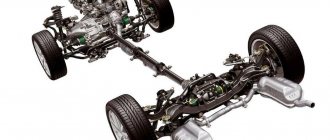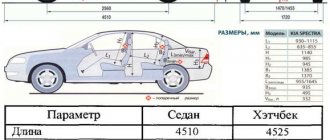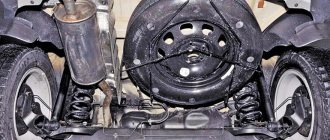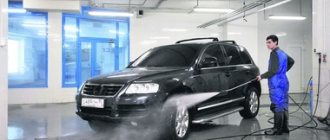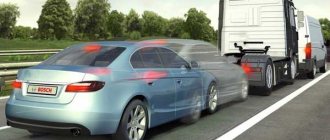What is a gearbox for?
Scheme of transmission of rotation to the wheels of a rear-wheel drive car
You can read about the purpose and location of pedals in a car
In order to understand the basics of driving a car with a manual transmission, it is enough, albeit superficially, to know the scheme of transmission of torque from the engine to the drive wheels. So, the engine is running, the car is on the parking brake, the gear lever is in neutral. This means that the engine shaft and clutch are rotating. Rotation is also transmitted to the gearbox input shaft, but since no gear is engaged, torque is not transmitted to the drive wheels and the car does not move. The clutch consists of two discs - the drive and the driven, pressed tightly against each other. The moment the driver depresses the clutch pedal (the leftmost of the three), the discs disengage and the transmission input shaft stops. In order for the car to start moving, you need to engage the gear and release the clutch pedal. Then the entire chain shown in the diagram will be combined into one whole and the engine torque will be transmitted to the drive wheels. On all-wheel drive cars, this scheme is somewhat complicated, which is not of fundamental importance in terms of learning to drive a car with a manual transmission.
Driving training: a little fun theory
The first part ends when a person receives a driver's license. Many people mistakenly begin to think that they have already become a driver. Not at all... I dare to assure you that you are not a driver yet. You are only a “candidate” to become a driver.
A person becomes a real driver after driving 10-20 thousand km around the city.
This is the second part of the training. However, a long drive around the city does not in itself guarantee an increase in skill. Many people, having years of driving experience behind them, remain “dummies” in the worst sense of the word. They are like talking parrots who speak well, a lot, but do not understand what they are talking about. Why is this happening?
It's all about driving ideology, i.e. main idea when driving:
- What is “CHEATER” thinking about? - I got there, survived and, thank God! How he got there is another matter.
— What is “RACER” thinking about? — Nothing!!! His legs do the thinking for him. For him, the main thing is to “give it to the max”, and then it will come out like a curve.
— What does a REAL DRIVER think about? — First of all, he thinks about safety!!! Secondly, it’s about comfort.
These two goals should be in the driver’s mind. Safety and comfort for yourself and surrounding passengers. In other words, driving should be beautiful. And you can and should get great pleasure from this beauty.
When driving around the city, 90% of the work is done with your head. And all mechanical work with hands and feet is the remaining 10%. Working with your head is not only the most voluminous, but also the most important part of driving. Learning to think while driving is a task even more important than learning to press the pedals and turn the steering wheel. Because a person who knows how to press on the gas with an empty head is precisely the one who is called “a monkey with a grenade.”
EVERYTHING IS IMPORTANT when it comes to driving. According to the degree of importance, everything is divided into important and fundamental. What is important is something that can be discussed to do or not to do. Fundamental things are not subject to discussion. This is sacred. Whether you want it or not, you ALWAYS have to do it, without exception. Because your safety, or, more simply put, your health and life, first of all depends on them.
All principles, as a rule, are simple and understandable, akin to axioms. For example. Where you look, you go there, where you don’t look, what happens there?.. That’s right, you don’t go! It would seem that what else is there to explain? After all, everyone knows this. But it’s not enough to know while driving. While driving you have to DO IT! After all, it is the failure to comply with this essentially elementary principle that leads to a lot of accidents.
Principle: while driving, you should always think first, then act. You should not allow yourself to make a single movement while sitting behind the wheel without thinking. Without thinking, you can only breathe. This principle is the basis of all security.
The driver must do everything related to driving a car “automatically”.
Driving a car is essentially dancing or playing a musical instrument. First, the student learns the necessary movements until they become automatic, and then, on the road, the arms and legs do everything as if by themselves. When you walk, you don’t think about how to move your feet?..
PATTERNS At first glance, the driver appears to make many movements, at different times, in different ways. There is an impression of chaos of movements. But look at the dancer. He also does a lot of different movements. How does he remember all this?
The point is that both have no chaos. In both cases, the movements consist of practiced combinations. Dancers call it "PA". In driving it will be called PATTERNS.
So, all actions when driving a car consist of templates. The task of training is to learn and practice these patterns until they become automatic. Any action while driving is a certain pattern.
— Starting the engine is a pattern.
— The beginning of movement is a pattern.
— Stopping is a pattern, etc.
This may seem strange, but all driving around the city is based on just one pattern - the turning pattern. All the driver’s actions, no matter what he does, are based on this one template.
The beauty of this technique is that it relieves the student of the need to learn and remember a lot of different movements in different situations. It is enough to work out several templates. While driving around the city, all you need to do is switch from one pattern to another. But that's not all. The main task is to work with the head (inspection, assessing the situation, making a decision on a maneuver), which should also consist of templates, and should also be practiced until it becomes automatic!
When starting training, the student keeps the order of actions in his head. With repeated turns, the exercise gradually turns into motor memory (motility), freeing the head. Having fully worked one exercise to the point of automatism, you can move on to another. In the next one, new elements are added, which at first are also controlled by the head, the previous ones are performed automatically. As they are practiced, these new ones are transferred to the monitor, freeing up the head for other elements.
So, gradually, element by element, all actions are stored in motor memory, freeing up the head for other work.
PSYCHOLOGY OF DRIVING Using your head, as already noted, constitutes the main part of the driving process. How the head works is greatly influenced by a person’s psychological mood. After all, sometimes it happens that an experienced driver, in upset feelings, drives a car worse than a beginner.
The principle follows from this: the driver behind the wheel should not have any emotions - neither positive nor negative. The logic is simple - while emotions are raging in the head, a person cannot think, and until he has thought, he has no right to do anything. Therefore, a very important part of driver training is to learn to manage your emotions! Simply put, don’t let them get to you. This is especially important in critical situations.
Managing a person’s emotional sphere is one of the most difficult tasks. It is the most difficult because the driver has to exercise control over himself. After all, if thoughts appear at the will of the mind, then emotions jump out absolutely not arbitrarily.
Once behind the wheel, the driver must get ready to drive. First, calm down. Secondly, “include” all the principles and rules of driving. The driver, in fact, is no longer even a person, he is a function, a “biorobot” performing a task that he has assigned to himself.
The ideal driver is Lieutenant Data from the Star Trek series. He knows everything, carries out everything according to instructions, constantly thinks, analyzes and has a complete absence of any emotions.
To a greater extent, emotional difficulties are a problem for female drivers. There is a well-known saying: a woman driving is a baboon with a grenade. And this, unfortunately, is true.
The whole secret is that there are no men or women behind the wheel. There must be a DRIVER behind the wheel!!! Once behind the wheel, a woman should immediately forget that she is a woman because she has ceased to be a woman; she is already a driver and only a driver. Those women who do this become good drivers. Sometimes even better than many men.
Driving training: a little fun theory
3 (60%) 1 vote[a]
Techniques for driving a car with a manual transmission
Before you start driving a car with a manual transmission for the first time, you should study its controls, the main ones of which are:
how to pass your car license the first time here
- steering wheel;
- clutch control pedal;
- brake pedal;
- accelerator (“gas”) pedal;
- gear selector lever;
- handbrake lever.
First lessons in driving a car with a manual transmission
about driving a car with automatic transmission here
So, you sat in the driver's seat for the first time. First of all, you need to look around, studying the location of the controls, the order of gear shifting, the pattern of which can be different - it is usually applied to the upper part of the gear lever handle, where the letter “R” means reverse gear. Next, we perform the following steps sequentially:
- It is necessary to adjust the seat so that the fit is comfortable and allows you to freely keep your hands on the steering wheel slightly bent and your feet on the pedals; Also adjust the rear view mirrors.
- Make sure that the car is held with the handbrake and the gearshift lever is in neutral (it should not be locked).
- Start the engine.
- Press the clutch pedal all the way down and engage first gear.
- Remove the car from the parking brake by pushing the brake lever down.
- Place your right foot on the gas pedal.
- Smoothly release the clutch pedal. To prevent the engine from stalling, lightly press the gas.
- As the car accelerates, change gears by squeezing the clutch and taking your foot off the gas.
Switch gears when the engine speed reaches 3000 - 4000 rpm. However, different car models have engine and gearbox characteristics that differ from each other, so a certain degree of perfection in driving can only be achieved through persistent practice.
Starting on a hill and stopping the car
You can read which brand of car a woman should choose here
In this case, learning to start moving begins on a special overpass. The car is set to a handbrake. When starting from a stop, it is necessary, with first gear engaged, to smoothly lower the handbrake lever, at the same time increasing the engine speed with the gas pedal and releasing the clutch pedal. At first, there will be problems with the coordination of actions that will appear as a result of training. In the future, as you acquire driving skills, you won’t even have to put the car on the handbrake. You will learn to move uphill, even if you hold the car while stopping by pressing the brake pedal, without using the handbrake lever. Stopping the car should be done by slowing down the engine speed and consistently shifting to lower gears, using engine braking. You should not get used to slowing down in neutral - this habit can seriously let you down on a slippery road. When learning to reverse, learn to navigate by the side rear-view mirrors - this skill will later help you park delicately in tight conditions. To control the speed in this case, use the clutch pedal without taking your foot off it - this will allow you to correct the direction in time and avoid a collision with any obstacle. By applying these simple rules for driving a car with a manual transmission in practice, you will gradually learn how to drive competently and without accidents.
Virtual driving instructor for cars with manual transmission
Where is the safest place in the car you can read here
To help novice drivers, various simulators have been developed that allow them to “try on” the role of a driver. But, despite fairly advanced developments in this direction, it is impossible to learn to drive with their help - no program can provide for all the surprises that arise in real life. However, they will help to practice reaction and speed of visual perception. Alternatively, you can purchase the licensed program “City Car Driving”. This is a game that simulates driving a car with a manual transmission. It has several levels of complexity, allowing you to create the appearance of movement in different weather conditions, with changes in lighting, etc. But no simulator can replace real experience, so practice and only practice!
City driving tutorial
Traffic rules 2010. Self-instruction manual for driving around the city (2009) Russian version of the game.
Genre: Education.
- Year of release: 2009;
- Developer: Exceed Entertainment;
- Publisher: IDDK;
- Publisher in Russia: IDDK;
- Language (localizer): Russian (original);
- Support for game controllers (steering wheel, pedals).
Description:
X-instructor. Self-teaching tutorial for driving around the city. Traffic rules 2010. Preparation and passing the exam.
The self-instruction manual will prepare you for theoretical and practical exams for obtaining a driver’s license of categories: A, B, C, D, and most importantly, it will help you master the skills of driving in a city, study the real routes of the Moscow traffic police examination departments.
Thanks to the 3D simulator, you can safely train to drive on the roads of Moscow under the supervision of a “virtual instructor” who will suggest the route and record mistakes.
You have a unique opportunity to be in an accident without threatening your life or wallet, and you will be able to “beat” and operate the training car as much as necessary to acquire confident driving skills.
And at the same time, without the cost of gasoline! Having experienced everything that a driver feels on the road in real life, in the future you will be able to avoid many mistakes and successfully pass the traffic police exam!
The Moscow State Traffic Safety Inspectorate recommends this tutorial for self-preparation for passing exams for driving licenses of categories A, B, C, D as a practical teaching aid.
Game Features:
- The latest official text of the Russian Federation Traffic Regulations in the format of an electronic reference book (with color illustrations). All changes and additions for September 2009 are highlighted in color;
- Ten districts of Moscow, reproduced with precision down to every road sign;
- Real routes of examination divisions of the Moscow State Traffic Safety Inspectorate;
- System for monitoring violations while driving;
- A virtual instructor who assists during training and supervises the exam run;
- Realistic traffic: traffic jams, special vehicles, violators;
- Practical part with a base of exam questions in categories: A, B, C, D. Testing knowledge of traffic rules: training and exam. The total base is 1600 questions.
Minimum system requirements:
- OS: Windows XP/2003
- CPU: Pentium IV 1.5 GHz
- VIDEO: GeForce 4400/Radeon 9200, 800*600 16 bit
- RAM: 512 MB
- SOUND: sound card
- HDD: 500 MB
Installation:
- Mount image.
- Install.
- Study.
It will also be useful to study a car driving simulator
City driving tutorial:
City driving simulator 2011
How much can you drink in the evening so that you can drive safely in the morning?
One of the characteristic features of “our man” is a predisposition to alcoholic beverages. Drinking for a meeting, for an acquaintance, in honor of a birthday, celebrating hundreds of other occasions, has become commonplace for many. And even the fact that the next morning, after a stormy party, will be tormented by a terrible migraine does not stop. It’s good if you don’t need to go anywhere, and you can just relax, lying on the couch. What if the next day after drinking you need to drive? And as luck would have it, at the moment when you are simply “smelling” with an abundance of alcoholic aromas, traffic inspectors suddenly show increased interest in you. Therefore, we will try to answer the burning question: how much can you drink in the evening in order to get behind the wheel in the morning?Driving tactics
Go ahead. The listed car driving skills are a component of driving skill, but they are not at all sufficient for full and safe driving. These skills will allow you to fully control the movement of the car as such and drive it well on an empty road, a mountain serpentine, for example. But a car is a “social” creature, and its management implies the presence of other traffic participants, compliance with traffic rules, taking into account road signs, markings, visibility conditions, etc.
And in order to take all this into account, there is a separate group of driving skills, which adds up to car driving tactics. These include the following:
- uniformity of movement
- economical driving techniques
- absence of useless and unplanned braking
- skills to create and maintain a safe space around the car
- knowledge of environmental safety criteria
- the ability to be visible to other road users
- ability to rationally observe the road and assess the situation
- ability to predict changes in the situation and respond in a timely manner
- knowledge of the criteria for safe, optimal speed in traffic
- ability to maintain and promptly change optimal speed
- ability to correctly choose the optimal speed in free driving conditions and in dense traffic
- ability to choose a safe speed depending on road visibility conditions
- 5 Ways to Rebuild Effectively
- safe advance and overtaking skills
- skills for safe driving on the main road
- ability to take into account the intentions of other road users
- the ability to consciously sacrifice one's priority
- the ability to take an optimal position on the road and not interfere with faster drivers
- understanding and use of the principle of rational priority of travel
And this is also not taught in driving schools.
As you can see, little of the above is studied in a driving school, and the worst part is that you can’t learn it in every driving school. Most of these skills in the West are called defensive driving, which in Russian is usually translated as “defensive driving.” This is the second third of what a good driver should know and be able to do.
At Kaminsky Driving School, you can partially master these skills in the “Safe City Driving” course (Level 2. Confident Driving) and complete defensive driving training in the top-level defensive driving course “MBA for Driver: Mastery of Driving.”
By completing this course and learning everything I have written about, you will rise to the level of an advanced driver - MBA - a master of driving a car.
So, the listed car driving skills will allow the driver to prevent emergency situations: to fully control the car and the road situation, to be aware of the level of risk of an accident at any given time, to manage the level of risk and reduce it to a minimum.
If you know all these techniques, this is, of course, great, but it is not enough to drive a car completely safely. After all, once a year the stick shoots, and the old woman suffers a blow. So no matter how you predict the development of the road situation and avoid accidents, sooner or later you may need skills to get out of extreme situations - emergency driving techniques.
